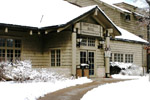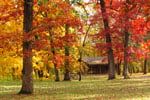SAND RIDGE STATE FOREST
For those who think central Illinois is one big corn field, Sand Ridge State Forest will come as a very pleasant surprise. The forest is an island in a sea of agriculture. Just minutes southwest of Peoria, this 7,200-acre, the largest of Illinois' State Forests, boasts sweeping expanses of native oak-hickory, extensive plantations of pine, sprawling open fields, grasslands, and completely unique sand prairies. For a refreshing, invigorating taste of unspoiled nature and an opportunity to experience truly unique environment, Sand Ridge State Forest is ideal.
The area is the result of a prehistoric dry period when more desert-like conditions existed. Today it remains one of the few places in Illinois that supports an intriguing variety of plants and animals more associated with the southwest than the midwest. Those include badger, silvery bladderpod, pocket gopher and prickly pear cactus to name a few.
The raw, undeveloped expanses of hardwood and pine blanketing the panoramic vistas contain miles of outstanding hiking, backpacking, snowmobiling, and horseback riding opportunities. Hunting of deer, turkey, pheasant, quail, dove, and squirrel is permitted. There is a hand trap shooting facility and an archery range.
For the dedicated outdoors person this is truly an island of great opportunity to see how diverse Illinois is. For the day visitor, the forest offers picnic facilities and the chance for fascinating experience with nature in the Henry Allen Gleason Nature Preserve. You can enjoy the pristine sand prairie in a protected area closed to vehicles, domestic animals and hunting.
A bird watcher's paradise, Sand Ridge State Forest also is an important nesting area for a great variety of neo-tropical migratory birds, such as ovenbird, indigo bunting, veery and scarlet tanager.
Fifteen thousand years ago the flood waters of the last glaciation period receded down the Illinois River valley leaving a vast deposit of sand near Pekin to down past Beardstown and as far west as San Jose. A subsequent period of extreme dryness and warmth invited plants and animals of the southwestern states to extend their range. Shifting winds sculpted 100 foot high sand dunes evident today as the now wooded ridges for which the forest is named.
In 1939, 5504 acres of this forested tract was purchased by the state to be managed by the Division of Forestry as an experimental forest. The Civilian Conservation Corps planted pine trees to control erosion and demonstrate the viability of growing a commercial tree crop in sandy soil. The current 2492 acres of pine plantations are still producing sawlog-size timber for Illinois' future needs. The native oak-hickory forest is selectively utilized for a firewood cutting program. There are special times throughout the year when firewood collection is allowed.
In 1971, the Division of Land Management took over management of the site and the area became known as Sand Ridge State Forest. Today, the forest covers 7200 acres -- 3916 acres of native oak-hickory forest, 2492 acres of pine, and the rest in open fields and sand prairies.
Day-UseFishingyes
Huntingyes
Hiking Trailyes
Swimming Beachyes
Bike Trailsyes
Bridle Trailsyes
BoatingLaunch Rampsyes
CampingPrimitiveyes
WinterActivitiesyes
If you and your family are interested in a rustic setting for camping, Pine Campground is the place for you. It contains 27 Class "C" sites featuring water, pit-vault toilets, fire pad, and a place to park two vehicles. Oak Campground provides open space, water, pit toilets, and council rings for organized group camping (Group Camp Reservation Application). Horseman's Park offers a staging area for equestrian camping, and horseback riding activities with hitching rails, water, pit toilets and a shelter area. Oak Campground and Horseman's Park have shelters that can be rented by sending a shelter reservation application to the forest headqueartes. Back-country camping is available at 12 primitive sites along the 55 miles of trail for a true wilderness camping experience. Users must obtain a permit from the Forest Headquarters prior to back-country use.
Groups of 25 people or more must have a Group Use Permit from the Site Superintendent. Activity Permits are required whenever a non-traditional use of any facility is requested and/or any activity that might increase potential liability tot he Department.




